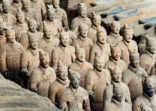The People’s Bank of China (PBoC) on Sunday lowered the RRR for banks by 100 basis points to 18.5% as it seeks to add more liquidity to the economy, help boost bank lending and combat a growth slowdown.
“The major reason for the RRR cut is the net forex outflows from China,” Grace Tam, global market strategist at J.P. Morgan Asset Management said.
“We have been seeing outflows from the mainland since the second half of the last year. If the trend continues, we are likely to see more RRR cut this year as the government needs to stabilise base money growth to avoid passive liquidity tightening due to outflows,” Tam added.
The latest easing could keep the market momentum, but chances of higher volatility cannot be ruled out, she said.
Market expectations on monetary easing were increasing after China reported a 7% year-on-year growth in the gross domestic product for the first quarter of 2015, slowest since 2009.
The announcement on Sunday still exceeded market expectations in terms of both the magnitude of the cut and timing, according to Luke Ng, vice president at FE Analytics said.
However, he sees further policy easing moves.
“As inflation goes lower, there is plenty of room for the PBoC to further cut rate in order to support economic growth and fight against potential deflationary pressure.”
Catherine Yeung, investment director at Fidelity Investments echoed similar sentiments last week.
“A couple of more interest rate cuts and a cut to the RRR are factored in by the markets. We are looking for further rate cuts,” Yeung said.
Craig Botham, emerging markets economist at Schroder’s had said on 15 April that stimulus efforts so far have not resulted in a “great acceleration in growth.”
The central bank had in early February cut the RRR by 50 basis points. This was followed by a 25 basis points cut in benchmark lending and deposit rates on 28 February, the second one since November.
“Monetary easing, for example, has not resulted in lower lending rates on new business because banks are trying to maintain net interest margins, while rates on existing lending are still higher in real terms despite nominal cuts, due to disinflation.”
Financial seen gaining
Banks, insurance, securities, and property sector companies are likely to be the beneficiaries from the easing move, according to Tam at J.P. Morgan,.
Ng at FE Analytics said banks are expected to benefit.
The portfolios of the top performing funds also show that most have a significant allocation to the financial sector.
Apart from the financial, consumer discretionary and industrial sectors also were among the preferred sector themes.
A-share boosting return
The top performing China equity funds over the last one year are the ones with exposure to the A-share market, which has surged since last November, particularly after the launch of the Stock Connect scheme and the rate cut.
Funds registered for sale in Singapore and/or Hong Kong with at least a three-year track record were considered for the list, which is based on FE data:
Topping the list are two products from BNP Paribas Investment Partners.
BNP Paribas Flexi Equity Small Caps China A
The Luxembourg-domiciled fund, which seeks to invest in small-cap companies, emerged as winner with a 146.2% return. The fund’s portfolio details were not available.
BNP Paribas Flexifund Equity China A
The Luxembourg-based vehicle followed with a 140.2% return.
The financial, consumer discretionary and healthcare companies dominated the fund’s portfolio with 30.8%, 16.1% and 16.1%, weighting respectively.
China Merchants Property Development, China Vanke Co and Shenzhen Accord Pharmaceutical were the largest three stock holdings.
Allianz China A-shares
The Luxembourg-based product seeks to invest in companies listed on the stock exchanges of Shanghai or Shenzen.
The top holdings of the fund were in Citic Securties, Poly Real Estate Group and Ping An Insurance Group.
In terms of sector allocation, the fund was overweight on the financial companies with a 38.6% weight compared to the 34.4% weight of the sector in the MSCI China A Total Return Index, the fund’s benchmark index.
It was also overweight on the industrial (22.3% compared to 18.8% weighting of the sector in the index) and consumer discretionary sector (13.7% versus 10.4%).
Hang Seng China A-Share Focus Fund
The Hong Kong-domiciled fund seeks to invest at least 70% of its assets in A-shares.
Financial companies dominated the fund’s portfolio with a 66% weighting. Industrial and consumer goods companies were also favored with a 15.3% and 12.1% allocation.
In line with the fund’s sector allocation, financial companies like Ping An Insurance, China Merchants Bank and China Minsheng Banking, Citic Securities and Industrial Bank featured in the top holdings.
Schroder China Equity Fund
The Hong Kong-domiciled fund also had the highest allocation toward financial companies, which accounted for 41.6% of the fund’s assets.
Industrial and information technology sectors followed with a 13% and 12.3% weighting, respectively.
Huatai Securities, Sinolink Securities and Sunshine City were the fund’s top holdings.
A look at the one-year performance of top performing China funds:

















